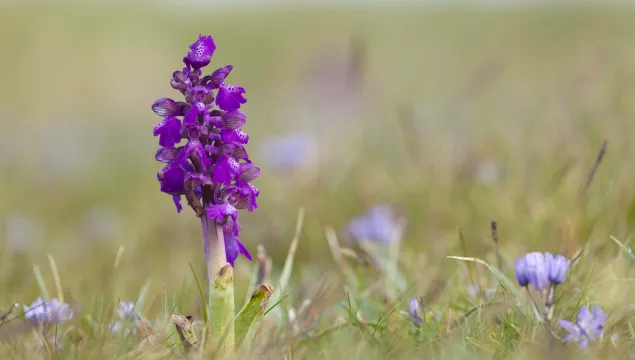Yellow iris
The large, sunshine-yellow flowers of the yellow iris brighten up the margins of our waterways, ponds, wet woods, fens and marshes. Also called the 'flag iris', its outer petals have a characteristic 'droop'.
The large, sunshine-yellow flowers of the yellow iris brighten up the margins of our waterways, ponds, wet woods, fens and marshes. Also called the 'flag iris', its outer petals have a characteristic 'droop'.
A climbing plant of hedgerows and woodlands, Black bryony produces greenish flowers in summer and red, shiny berries in autumn. It is a poisonous plant.
The Marsh helleborine is a beautiful orchid of fens, wet grassland and dune slacks. Growing in profusion in places, look for reddish stems and white-and-pink flowers.
A tall orchid of woodland and scrub, the broad-leaved helleborine has greenish, purple-tinged flowers that look a little 'drooping'. Strongly veined, oval leaves spiral around its stem.

A short, but pretty plant of unimproved grasslands, the Green-winged orchid gets its name from the green veins in the 'hood' of its flowers. Look for it in May and June.
The Yellow star-of-Bethlehem is a woodland plant that lives up to its name - it displays starry, gold flowers in an umbrella-like cluster in early spring.
Look for the pretty, star-shaped, white flowers of Lesser stitchwort in woodlands and meadows, and along hedgerows and roadside verges in spring. Its flowers are smaller than those of Greater stitchwort.
The bulbous buttercup has the familiar butter-yellow flowers of its namesake, but grows from a bulb-like 'corm' (a swollen underground stem). Look for it on chalk and limestone grasslands, and along verges.
The Greater butterfly-orchid is a tall orchid of hay meadows, grasslands and ancient woodlands. It has whitish-green flowers that have spreading petals and sepals - a bit like the wings of a butterfly.
Often overlooked, Lesser centaury is a tiny plant of grassy, open habitats like dunes, cliffs, heaths and grasslands. As its name suggests, it is much smaller than its relative, Common centaury.
A 'weed' of cultivated and disturbed ground, Round-leaved fluellen is a trailing plant with round leaves and yellow flowers that appear over summer.
Dittander is a herb of coastal saltmarshes and damp ground. Its waxy leaves and long roots help it to survive in this harsh environment. Due to its peppery taste, it has also become a popular garden plant.